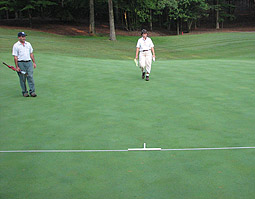Those Strange Blue Dots
"What are the blue dots used for in front and back of every green?" This question from a caddie in a recent USGA championship is the focus of this update. Hole locations is the simple answer, but we will use the two 2008 USGA championships hosted by golf courses in the Southeast Region as examples to elaborate on this answer.
 |
Selecting hole locations at a championship is far more than going out on the morning of a competition and finding a good place to locate the hole. Plenty of work is done in advance of championship week and there are numerous factors to consider. First, the USGA staff person in charge visits the course months in advance to scout for potential hole locations. Nothing is set in stone as no one can be sure that turf quality will remain the same in a location or how this hole location will fare at championship green speeds. This advance work gives the staff time to study the putting greens and create a game plan for each round that balances out difficulty depending on the round or circumstances.
The staff person typically selects six locations for the championship plus two for the practice rounds. Efforts are made to balance out front and rear locations as well as left and right locations. Practice round locations are placed in areas away from competition hole locations.
Years ago, a USGA staff person would go out in the afternoon or evening prior to a round and paint a small dot indicating the next day's hole location. This method has since been abandoned with a more efficient and accurate system. If you attend any USGA championship you will notice a blue dot in the front and rear of every putting green.
The two blue dots identify the exact front and back of the green as measured by the USGA, and the line between them is the basis for determining the total green depth and measuring the depth of each day's hole location. The back of the putting green is determined first. The easiest way to find the exact back of a putting green is to stand at the very rear of the green and line up with the middle of the fairway landing area or the middle of the tee on par 3's matching the line players will follow on their approach to the green. The exact spot in the back is where this line divides the green into approximately two equivalent halves. If this spot is not on the back edge off the green, it is the point perpendicular to any deepest edge of the green, and is not necessarily on the edge of the putting green surface. Once this point is established, the front of the green can be marked, and will be on the same imaginary line. Just as is the case for the back, the front of the green may not be on the edge of the green. Once the front and back are determined, a blue dot is painted at each point, and the green depth is the distance, in yards, from dot to dot.
When it is game time, the USGA staff person and a hole changer from the maintenance staff assemble to set up the golf course early each morning ahead of play. They lay out a tape measure between the two blue dots to indicate the accurate depth of the hole location. A small pvc t-square is placed on the tape and used to assist in pacing off the hole location from the side edge of the green. Let's say the hole location on Hole 1 is listed as 15-11 right. This means the hole is located 15 yards from the front of the green and 11 yards from the right edge. The t-square is placed at 15 yards on the tape measure and 11 yards are paced from the right edge of the green towards the center, keeping in line with the t-square. Once the spot is identified, the USGA staff person will look for any unusual blemishes or damage to the turf and they will putt a few balls to make sure the location is fair. Finally, the hole changer is given the green light to cut the new hole.
Selecting hole locations for golf championships is a blend of art and science. Officials in charge of hole locations face the task of identifying interesting hole locations and selecting a grouping of 18 hole locations appropriate for the day's play. Once the holes are indentified, key steps are taken to make sure the locations are accurate and the information is disseminated to players. The system described above allows for greater consistency and enables any staff person to complete the task. Hopefully, some of the ideas presented here provide some background on how the USGA selects hole locations and it may provide you with a few tips for your course.
Source: Patrick O'Brien 770-229-8125 or
patobrien@usga.org
and Chris Hartwiger 205-444-5079 or
chartwiger@usga.org
